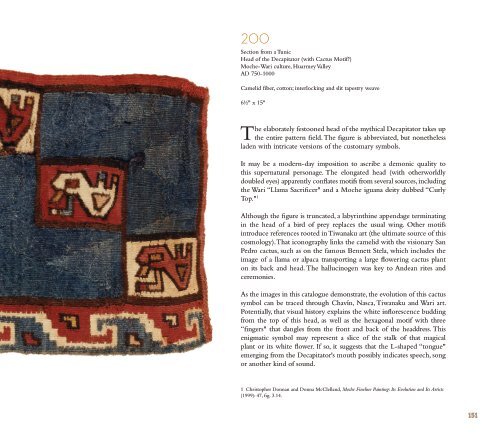You also want an ePaper? Increase the reach of your titles
YUMPU automatically turns print PDFs into web optimized ePapers that Google loves.
200<br />
Section from a Tunic<br />
Head of <strong>the</strong> Decapitator (with Cactus Motif?)<br />
Moche-Wari culture, Huarmey Valley<br />
AD 750-1000<br />
Camelid fiber, cotton; interlocking and slit tapestry weave<br />
6½" x 15"<br />
The elaborately festooned head of <strong>the</strong> mythical Decapitator takes up<br />
<strong>the</strong> entire pattern field. The figure is abbreviated, but none<strong>the</strong>less<br />
laden with intricate versions of <strong>the</strong> customary symbols.<br />
It may be a modern-day imposition to ascribe a demonic quality to<br />
this supernatural personage. The elongated head (with o<strong>the</strong>rworldly<br />
doubled eyes) apparently conflates motifs from several sources, including<br />
<strong>the</strong> Wari “Llama Sacrificer" and a Moche iguana deity dubbed “Curly<br />
Top." 1<br />
Although <strong>the</strong> figure is truncated, a labyrinthine appendage terminating<br />
in <strong>the</strong> head of a bird of prey replaces <strong>the</strong> usual wing. O<strong>the</strong>r motifs<br />
introduce references rooted in Tiwanaku art (<strong>the</strong> ultimate source of this<br />
cosmology). That iconography links <strong>the</strong> camelid with <strong>the</strong> visionary San<br />
Pedro cactus, such as on <strong>the</strong> famous Bennett Stela, which includes <strong>the</strong><br />
image of a llama or alpaca transporting a large flowering cactus plant<br />
on its back and head. The hallucinogen was key to Andean rites and<br />
ceremonies.<br />
As <strong>the</strong> images in this catalogue demonstrate, <strong>the</strong> evolution of this cactus<br />
symbol can be traced through Chavín, Nasca, Tiwanaku and Wari art.<br />
Potentially, that visual history explains <strong>the</strong> white inflorescence budding<br />
from <strong>the</strong> top of this head, as well as <strong>the</strong> hexagonal motif with three<br />
“fingers" that dangles from <strong>the</strong> front and back of <strong>the</strong> headdress. This<br />
enigmatic symbol may represent a slice of <strong>the</strong> stalk of that magical<br />
plant or its white flower. If so, it suggests that <strong>the</strong> L-shaped “tongue"<br />
emerging from <strong>the</strong> Decapitator's mouth possibly indicates speech, song<br />
or ano<strong>the</strong>r kind of sound.<br />
1 Christopher Donnan and Donna McClelland, Moche Fineline Painting: Its Evolution and Its Artists<br />
(1999): 47, fig. 3.14.<br />
151







